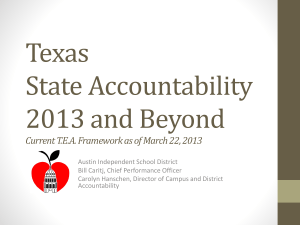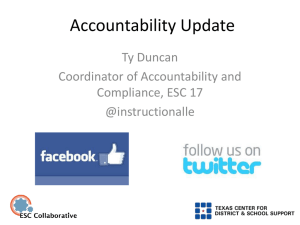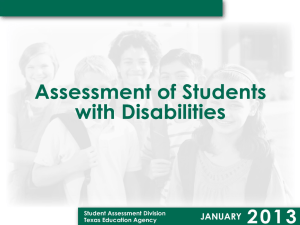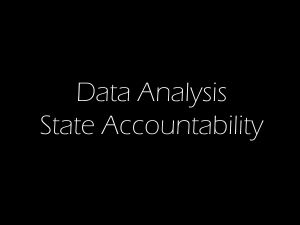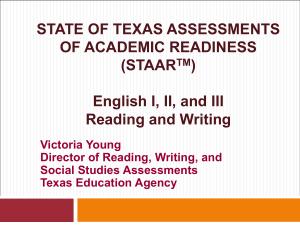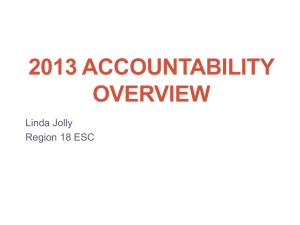2014-2015 ARD Committee State Assessment Decision
advertisement
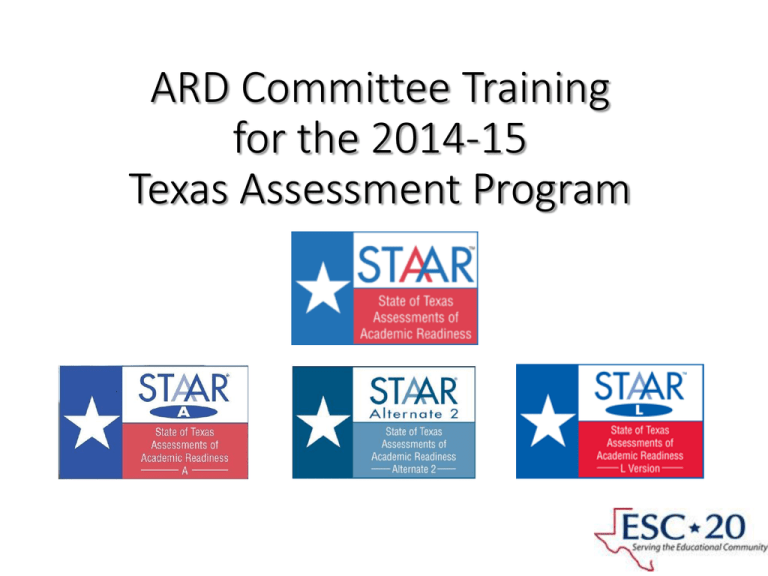
ARD Committee Training for the 2014-15 Texas Assessment Program Presented by ESC Region 11 Fort Worth, Texas The ARD committee reviews the student's PLAAFP and instructional goals and determines how the student accesses the grade-level/course curriculum (TEKS). With or without accommodations STAAR With accommodations Through prerequisite skills and meet participation requirements and meet eligibility criteria* STAAR SOA STAAR® Alternate2 or STAAR® Accommodated *This is not dependent on student receiving modified instruction. *Adapted from ARDC training 2013-2014. What does “access” mean? Access = a means of approach… how a teacher exposes a student to the grade-level/course TEKS STAAR ® Alternate2 STAAR®/ STAAR® SOA/ STAAR® Accommodated* Instructional Focus Instruction covers all of the required curriculum Access Method Accommodations *This is not dependent on student receiving modified instruction Individualized instruction that exposes the student to selected knowledge and skills statements through aligned student expectations from earlier grades Prerequisite skills linked to grade-level/ course curriculum Instructional Examples Extra time, formatting changes, manipulatives, spelling assistance, transcribing, calculator Individualized supports, materials, and response modes to compensate for the student's disability *Adapted from ARDC training 2013-2014. 2015 Assessment Cycle STAAR Accommodations Individualized Structured Reminders Amplification Devices Projection Devices Manipulating Materials Oral/Signed Administration Spelling Assistance Math Manipulatives Calculation Devices Basic Transcribing Supplemental Aids Extra Time Large Print Dictionary Braille RtI, 504, Special Education Complex Transcribing Math Scribe Special Education Photocopying Extra Day Be sure to check the eligibility criteria as well as the assessments on which the Other 504 or Special Education accommodation(s) may be used. PDFs of each accommodation can be found on TEA’s website or by clicking here. In the case of an ELL with a disability, the decision should be made by the applicable group (RtI Committee, 504 Committee, ARD Committee) in conjunction with the student’s LPAC. *ARF – Accommodation Request Form Until Type 2 accommodations are approved by TEA, all paperwork should read “pending TEA approval.” Created by Erin Kelts What should an ARD committee know prior to making an assessment decision for a student? ARD committees must understand: • • • • • What state assessments are required and available Assessed TEKS and/or ELPS Participation requirements for specific assessments Design and format of each state assessment Accommodation policies for the STAAR® programs *Adapted from ARDC training 2013-2014. Remember that the PLAAFP drives the rest of the IEP – consider if the needs indicated in the PLAAFP justify the accommodations that are being recommended. There MUST be a direct and consistent correlation between the PLAAFP, goals, supports and the testing decision! PLAAFP Goals Supports Supports Accommodations Placement/Time State Assessment What should an ARD committee consider first when making assessment decisions? • Participation in the general assessment should be the first consideration when determining the appropriate assessment for a student receiving special education services. General assessment = STAAR® • Most students receiving special education services in Texas are assessed with the general assessment, with or without accommodations. Students should be challenged with the most rigorous assessment possible. *Adapted from ARDC training 2013-2014. The First Consideration = The General Assessment ARD committees must determine whether the general assessment is the most appropriate by: • Reviewing the student’s present level of academic achievement and functional performance (PLAAFP) • The PLAAFP should provide the committee members with a clear understanding of the student’s performance in the gradelevel/course TEKS, including strengths, current areas of need, and accommodations, modifications, or supports used. *Adapted from ARDC training 2013-2014. The First Consideration = The General Assessment ARD committees must determine whether the general assessment is the most appropriate by: • Reviewing the student’s instructional plan • This is the basis for making appropriate assessment decisions. • The ARD committee must have a clear understanding of how the student will access the grade-level/course curriculum, including accommodations, modifications, or supports needed. *Adapted from ARDC training 2013-2014. What should be documented in the student’s IEP when considering the general assessment? • If STAAR®, with or without accommodations, is appropriate for a student, the ARD committee must document this decision and the testing accommodations the student will receive. • Documented testing accommodations must be consistent with state accommodation policies. • It is important to note that there are different accommodation policies for the STAAR® and TAKS programs • Refer to the Accommodations Resources webpage. http://tea.texas.gov/student.assessment/accommodations/ • For accommodations that require TEA approval through submission of an Accommodation Request Form*, document “pending TEA approval.” *Open January, 2015 http://tea.texas.gov/Student_Testing_and_Accountability/Testing/Student_Assessment_Over view/Accommodation_Resources/2015_Accommodations_for_Students_with_Disabilities_Ta king_State_Assessments/ *Adapted from ARDC training 2013-2014. SSI: 2014-15 School Year • There is no SSI for grades 5 & 8 Mathematics. • The SSI manual will be updated to reflect STAAR® A as an assessment option. STAAR®, with or without allowable or approved accommodations, should be the first consideration. Allowable Accommodations The decision to use an accommodation during a state assessment is made on an individual student basis and considers the needs of the student and whether the student routinely receives the accommodation during classroom instruction and testing. *Adapted from ARDC training 2013-2014. Using Accommodations on State Assessment http://tea.texas.gov/student.assessment/accommodations/ Accommodation type This section provides a general description of the accommodation. This section lists the assessments the accommodation may be used on by eligible students. This section lists the eligibility criteria that must be met in order for the student to use the accommodation on a state assessment. This icon indicates whether or not an Accomm. Request Form is required. This section describes who can make accommodation decisions for students, where to document these decisions, and what to record on the answer document. This section describes the specific examples/types of the accommodation that may be used on the state assessment. Pay careful attention to this list because it is sometimes exhaustive. This section outlines special instructions and considerations about the accommodation that educators must be aware of when making the decisions to use the accommodation and when administering the assessment with the accommodation. From TEA Accommodations Training Pay attention that there may be multiple eligibly criteria (In this case, 3 criteria; meets at least one of the following) Key words: inclusive , meets all, meets at least, and, etc. Using Accommodations on State Assessment If you are recommending accommodations for students to use on state assessment, be prepared to show data, documentation, work samples and justification as to why a student should use the accommodation. As well, it must be properly documented in their IEP, 504 plan, LEP documentation, etc. Standardized Oral Administration (SOA) for the STAAR® TEA is offering Standardized oral administration for the STAAR® program as an online option for oral administration. The option is available statewide to eligible students in the following grades and subjects: • • • • • grade 4 reading and mathematics (English only) grade 5 science (English only) grade 6 reading and mathematics grade 7 reading and mathematics grade 8 science and social studies The SOA forms feature a text-to-speech panel that students can use to hear selected text in test questions, answer choices, and graphics similar to the way it is on the traditional oral administration of a paper assessment. *From TEA SOA Resources Standardized Oral Administration (SOA) for the STAAR® The online tool through which SOA is delivered allows a student to independently select and change his or her level of reading support during the test administration. SOA should only be administered to an eligible student for whom the appropriateness of this type of oral administration has been discussed and documented. *From TEA SOA Resources Standardized Oral Administration (SOA) for the STAAR® It is recommended that the students complete the STAAR® SOA online tutorial (SOA webpage) prior to test administration. This tutorial allows students to become familiar with the tools available to them during the online SOA test session. http://tea.texas.gov/student.assessment/SOA/ *From TEA SOA Resources Oral/Signed Admin Type 1 A student may use this accommodation if he or she • routinely and effectively uses this accommodation during classroom instruction and testing, and • meets at least one of the following: Special Education Section 504 identified with dyslexia or a related disorder per TEC §38.003 identified with dyslexia or a related disorder per TEC §38.003 evidence of reading difficulties evidence of reading difficulties General Education identified with dyslexia or a related disorder per TEC §38.003 *Does not have to denote in IEP that the student will be taking the SOA version… just that they have to be OA eligible *From TEA SOA Resources TEC §38.003 (1) "Dyslexia" means a disorder of constitutional origin manifested by a difficulty in learning to read, write, or spell, despite conventional instruction, adequate intelligence, and sociocultural opportunity. (2) "Related disorders" includes disorders similar to or related to dyslexia, such as developmental auditory imperception, dysphasia, specific developmental dyslexia, developmental dysgraphia, and developmental spelling disability. *From STAAR Accommodations Training October, 2014 See the SOA Resources page for additional information: http://tea.texas.gov/student.assessment/soa/ What should be documented in the student’s IEP when considering the general assessment? • If the STAAR assessment with accommodations, is not appropriate for a student, the ARD committee must review the eligibility requirements for STAAR® A. Introduction to STAAR® A • STAAR® A will be the same as STAAR® in the following ways: • • • • • Same passing standards Same time limits Same assessed curriculum Same test blueprint Same progress measures • STAAR® A will be different than STAAR® in the following ways: • No field test questions • Online administration • Embedded accommodations and accessibility features *From STAAR Accommodations Training October, 2014 STAAR® A Eligibility Requirements Eligibility Requirements If a student cannot access STAAR® with or without allowable accommodations, he or she must be receiving the following services in order to consider STAAR® A: • Students with identified disabilities who are receiving special education services • Students identified with dyslexia or a related disorder (as defined in Texas Education Code §38.003) and are receiving Section 504 services A student may take STAAR® in some subjects and STAAR® A in other subjects, depending on eligibility. STAAR® A Accommodations Guidelines Tools Embedded Accommodations Accessibility Features Answer Eliminator Pop-ups Text-to-Speech Highlighter Rollovers Zoom Eraser Blank Graphic Organizers Color and Contrast Pencil Writing Checklists Place Marker Notepad Dot Tool* Line Tool* Ruler* Calculator* Reference Materials* *These tools are subject-specific and only appear in subject tests where they are relevant. STAAR® A Accommodations Guidelines http://tea.texas.gov/index2.aspx?id=25769817490&menu_id=793 Eligibility Requirements STAAR® Accommodated • The STAAR® A Eligibility Requirements are state-required documentation forms that must be completed and included in the IEP. • This form is retained locally. State-Required Documentation Forms • For STAAR® A, the district personnel completing the form needs to be identified by name on the form, along with his or her position. • The district personnel named in the form is responsible for making sure the ARD committee discusses each section. • The district personnel who completes these forms should be a member of the ARD committee (e.g., special education teacher, ARD facilitator, administrator). These forms should be completed during the ARD committee meeting when assessment decisions are made. Eligibility Requirements • To be eligible to participate in STAAR® A, the answer to all of the eligibility statements on page one of the eligibility requirements must be “Yes.” • If the answer to any of these eligibility questions is “No,” the student is not eligible to participate in that assessment and must participate in one of the other state assessments. Step I: Review the Eligibility Criteria for STAAR® A • The ARD committee must be able to check these two eligibility statements in order for the assessment to be considered appropriate for a student. Step II: Review Eligibility Criteria for STAAR® A The ARD or Section 504 committee (in conjunction with the LPAC if the student is an ELL) must circle the subject(s) for which STAAR® A is being considered and check the accommodation(s) the student routinely receives in the classroom for that subject. If a particular subject is not applicable, circle NA. To be eligible to participate in STAAR® A in a particular subject, TWO OR MORE accommodations must be checked in that subject. If fewer than two accommodations are checked, the student is not eligible to participate in STAAR® A in that subject. Step II: Review Eligibility Criteria for STAAR® A • A list of testing accommodations consistent with the state accommodation policies is posted on the TEA Resources webpage. • In order to make appropriate accommodation decisions from year to year, their effectiveness should be assessed. • Collect data on how the student performs with and without the accommodation. • Make available to the student a variety of instructional strategies to see which are most effective. • Students taking STAAR® A may be receiving instruction in any setting (e.g., inclusion, resource, self-contained) or for any amount of time. ARD committee decisions should be based only on the educational needs of a student. Step II: Review Eligibility Criteria for STAAR® A It is not appropriate to make an assessment decision simply because a student passed or failed a previous state assessment. Example: If a student achieved Satisfactory Academic Performance on STAAR® Alternate at Complexity Level 3 in the past, this does not necessarily mean that the student should now take STAAR ®. Other factors must be considered. Example: If a student received an Unsatisfactory Academic Performance on STAAR® Modified in the past, it does not automatically mean that the student should now take STAAR® A or STAAR ® Alternate 2. Students must meet eligibility criteria for STAAR® A or the participation requirements for STAAR® Alternate 2. Step III: Summarize Assessment Decisions for STAAR® A • The ARD or Section 504 committee (in conjunction with the LPAC if the student is an ELL) should indicate the STAAR® A test(s) the student will take for the school year under consideration. This form must be included in the student’s IEP or IAP to serve as the required documentation of the state academic achievement decision • Additional testing accommodations may be allowed and must be documented in the student’s paperwork as well. Refer to the Accommodation Triangle on the TEA Student Assessment website for more information See the STAAR® A Resources page for additional information: http://tea.texas.gov/index2.aspx?id=25769817490&menu_id=793 For Additional Information: ® http://www.esc20.net/default.aspx?name=ci_staar.SpecialEducation Participation Requirements Participation Requirements STAAR® Alternate 2 • The STAAR® Alternate 2 Participation Requirements are staterequired documentation forms that must be completed and included in the IEP. • This form is retained locally. State-Required Documentation Forms • For STAAR® Alternate, the district personnel completing the form needs to be identified by name on the form, along with his or her position. • The district personnel named in the form is responsible for making sure the ARD committee discusses each section. • The district personnel who completes these forms should be a member of the ARD committee (e.g., special education teacher, ARD facilitator, administrator). These forms should be completed during the ARD committee meeting when assessment decisions are made. Participation Requirements • To be eligible to participate in STAAR® Alternate 2, the answer to all of the eligibility questions on page one of the participation requirements must be “Yes.” • If the answer to any of these eligibility questions is “No,” the student is not eligible to participate in that assessment and must participate in one of the other state assessments. Step I: Review the Eligibility Criteria for STAAR® Alternate 2 • Eligibility is considered for all assessed subjects in the student’s enrolled grade or all assessed courses the student is enrolled in. • If the student is eligible to take STAAR® Alternate 2, then he/she must take this assessment for all subjects/courses. Mixing assessments is not allowed. Step I: Review the Eligibility Criteria for STAAR® Alternate 2 • The ARD committee must answer “Yes” to these four eligibility questions in order for the assessment to be considered appropriate for a student. • Does the student have a significant cognitive disability? • Does the student require specialized supports to access the grade-level curriculum and environment? • Does the student require intensive, individualized instruction in a variety of instructional settings? • Does the student access and participate in the grade-level TEKS through prerequisite skills? Step I: Review the Eligibility Criteria for STAAR® Alternate 2 • The ARD committee must review each of the four questions and circle YES or NO. • Each “Yes” answer requires a justification that contains evidence that the student meets the criteria. The recorded justification does not have to be referenced by IEP page numbers, but should be based on quantifiable evidence. Based on PLAAFP; narrative/anecdotal; not just IEP page/section number Eligibility Criteria – Question 1 • A significant cognitive disability is determined by the ARD committee and must be based on evaluation information performed by a qualified evaluation team. • The disability must affect the student’s intellectual potential and be documented in the student’s IEP. • A student with a significant cognitive disability has limited potential to reach grade-level expectations. • While a student with a learning disability may have academic challenges, he or she has the intellectual potential to reach grade-level expectations and, therefore, is not eligible to take STAAR Alternate 2. Justification (Example): Based on Amy’s most current FIE, her full scale IQ falls well below 70 indicating a limitation in intellectual functioning. Adaptive behavior scales indicate significant deficits in the following domains: self-care, socialization, and communication skills. The team agrees that she meets the eligibility criteria for STAAR Alternate 2 as a student with an intellectual disability. Eligibility Criteria – Question 2 • Federal regulations mandate that all students have access to and be assessed on grade-level curriculum. • To access the grade-level curriculum, a student with a significant cognitive disability needs specialized academic instruction. • Additionally, a student eligible for STAAR Alternate 2 requires support throughout the day in areas such as communicating needs, navigating the classroom or school building, eating lunch, negotiating social situations, and/or taking care of personal needs. Justification (Example): Amy has difficulty attending to tasks and requires numerous redirections to stay focused. When in a large group for instruction, Amy is easily distracted and does not process language well. Her expressive language delays make it difficult for Amy to express her needs in a large group. Because of this, Amy requires specialized instruction in a small group setting for academic skills. Amy’s weak language skills also make it difficult for her to respond appropriately in social situations; therefore, she requires assistance during nonacademic school activities. Amy requires assistance to perform all self-care skills. Eligibility Criteria – Question 3 • The student needs specialized academic instruction and techniques over a period of time to learn and retain information. • Instruction in a variety of settings is required in order for the student to transfer skills (generalize). Justification (Example): Amy’s short attention span and distractibility require her to need numerous repetitions and drill in order to retain knowledge. Additionally, she acquires and retains knowledge best when skills are taught in the setting or situation in which the skill naturally occurs. For example, to address a social studies prerequisite skill involving economics, Amy was more successful in purchasing an item in the school store rather than in a classroom simulation. Eligibility Criteria – Question 4 • Access to the grade-level curriculum is mandated by the federal government. • A student with a significant cognitive disability requires access to the TEKS through prerequisite skills. • Prerequisite skills are student expectations from previous grades that are linked to the grade-level curriculum. Justification (Example): Although Amy shows relative strengths in the areas of math calculation and math reasoning, she is performing skills that are several grade levels behind her grade 8 peers in all academic areas. Her access to the grade-level TEKS is through prerequisite skills. Instructional Terms List Step II: Discuss Assurances for STAAR® Alternate 2 If “Yes” is indicated for all of the eligibility questions for STAAR Alternate 2, the ARD committee must discuss the assurances in Step II, and the district personnel completing the form must initial each one after it is discussed. Step II: Discuss Assurances for STAAR® Alternate 2 When an alternate assessment is selected, IDEA and The Legal Framework for the Child-Centered Special Education Process require ARD committees to document in the IEP: • A statement of why the student cannot participate in the general assessment, with or without allowable accommodations, AND… • A statement of why an alternate assessment is appropriate for the student, including evidence from the IEP that confirms that the answer to each of the questions for STAAR® Alternate 2 is “Yes” Step II: Discuss Assurances for STAAR® Alternate 2 A list of testing accommodations consistent with the state accommodation policies posted on the TEA Resources webpage for STAAR® Alternate 2. • In order to make appropriate accommodation decisions from year to year, their effectiveness should be assessed. • Collect data on how the student performs with and without the accommodation. • Make available to the student a variety of instructional strategies to see which are most effective. Step II: Discuss Assurances for STAAR® Alternate 2 It is not appropriate to make an assessment decision simply because a student passed or failed a previous state assessment. • Example: If a student achieved Satisfactory Academic Performance on STAAR® Alternate at Complexity Level 3 in the past, this does not necessarily mean that the student should now take STAAR ®. Other factors must be considered. • Example: If a student received an Unsatisfactory Academic Performance on STAAR® Modified in the past, it does not automatically mean that the student should now take STAAR® A or STAAR ® Alternate 2. Students must meet eligibility criteria for STAAR® A or the participation requirements for STAAR® Alternate 2. Step II: Discuss Assurances for STAAR® Alternate 2 • ARD committee decisions should be based only on the educational needs of a student. • If a student meets the participation requirements for STAAR® Alternate 2, then he or she should be administered that assessment. Step II: Discuss Assurances for STAAR Alternate® 2 • Only students with significant cognitive disabilities are eligible to take STAAR® Alternate 2 and all four eligibility questions must be answered “Yes.” • Students taking STAAR® Alternate 2 may be receiving instruction in any setting (e.g., inclusion, resource, self-contained) or for any amount of time. Step II: Discuss Assurances for STAAR® Alternate 2 Step II: Discuss Assurances for STAAR® Alternate 2 Students are only eligible to take STAAR® Alternate 2 if they are accessing the curriculum through prerequisite skills linked to the grade-level curriculum. For high school students, these courses are denoted by a special PEIMS code. Step III: Summarize Assessment Decisions for STAAR® Alternate 2 • The ARD committee should indicate the subject(s) or course(s) in which the student is enrolled and for which STAAR® Alternate 2 assessments will be given. • The student will take STAAR® Alternate 2for all required subjects or enrolled high school courses. Medical Exception No Authentic Academic Response (NAAR) ME, NAAR, & ACCOUNTABILITY • Is there a limit to the number of students that can be ME or NAAR in a campus/district? • No set percentage, however high percentages may draw attention • Complete all necessary paperwork and considerations • How will NAAR impact campuses for accountability? • (M and N) codes will be treated like an O code for participation, but not for performance. • Scoring standard has not been set. (Anticipated date is May, 2015.) See the STAAR® Alternate 2 Resources page for additional information: http://tea.texas.gov/student.assessment/special-ed/staaralt/ For Additional Information: ® http://www.esc20.net/default.aspx?name=ci_staar.SpecialEducation Assessment Decisions for ELLs Receiving Special Education Services Assessment Decisions for ELLs Receiving Special Education Services • ELLs receiving special education services may be administered any assessment depending on whether they meet the participation requirements • STAAR • STAAR Spanish • STAAR L • STAAR Alternate • Chapter 101 of the TAC requires the LPAC to work in conjunction with the ARD committee to make assessment decisions for these students • The collaboration helps ensure that factors related to disabling conditions and second language acquisition are both carefully considered From TEA Student Assessment Division “Training on the LPAC Decision-Making Process for the Texas Assessment Program” STAAR® A and STAAR® Alternate • Important: ELLs participate in these assessments only on the basis of their disability, not second language acquisition • The LPAC’s involvement in assessment decisionmaking for ELLs served by special education should help ensure that ELL participation in these assessments is appropriate Adapted From TEA Student Assessment Division “Training on the LPAC Decision-Making Process for the Texas Assessment Program” English Proficiency Exit Criteria Retrieved from: http://tea.texas.gov/index2.aspx?id=4098 English Proficiency Exit Criteria See the STAAR ® L Resources page for additional information: http://tea.texas.gov/student.assessment/ell/staarl/ Contact Information: • The district testing coordinator is the primary contact when questions arise. • TEA’s Student Assessment Division: Accommodation Task Force • 512-463-9536 • Accommodations Email: • Test.accommodations@tea.state.tx.us Related Resources http://tea.texas.gov/Student_Testing_and_Accountabil ity/Testing/Student_Assessment_Overview/Accommo dation_Resources/2015_Accommodations_for_Studen ts_with_Disabilities_Taking_State_Assessments/ 10/27/14 Letter from TEA: Assessment Participation Requirements for Students Receiving Special Education Services Critical Information for Students with Disabilities taking State Assessment Accommodations in Unexpected or Emergency Situations Accommodation Request Process for Type 2 Accommodations Educator Guide for STAAR A and STAAR Alternate 2
